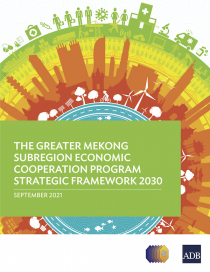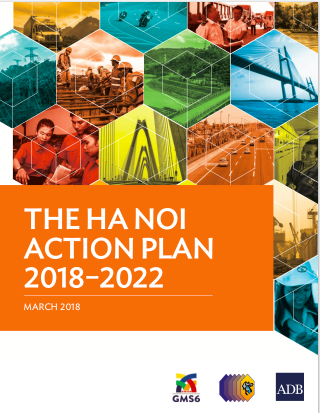Strategy
The Greater Mekong Subregion (GMS) Economic Cooperation Program Strategic Framework 2030
 The Greater Mekong Subregion Economic Cooperation Program Strategic Framework 2030 (GMS-2030) was endorsed and adopted at the 7th GMS Summit of Leaders hosted by Cambodia in September 2021. With a vision to develop a more integrated, prosperous, sustainable, and inclusive subregion. The GMS-2030 establishes a new Mission Statement for the GMS Program: a subregional cooperation program focused on its fundamental strengths of community, connectivity, and competitiveness, while embracing the core principles of environmental sustainability and resilience, internal and external integration, and inclusivity, for building a GMS community with a bright shared future. These core principles will be infused across all initiatives of the GMS Program.
The Greater Mekong Subregion Economic Cooperation Program Strategic Framework 2030 (GMS-2030) was endorsed and adopted at the 7th GMS Summit of Leaders hosted by Cambodia in September 2021. With a vision to develop a more integrated, prosperous, sustainable, and inclusive subregion. The GMS-2030 establishes a new Mission Statement for the GMS Program: a subregional cooperation program focused on its fundamental strengths of community, connectivity, and competitiveness, while embracing the core principles of environmental sustainability and resilience, internal and external integration, and inclusivity, for building a GMS community with a bright shared future. These core principles will be infused across all initiatives of the GMS Program.
GMS-2030 promotes innovative approaches in key cross-cutting areas. These include (i) harnessing the digital revolution to transform important sectors of the economy toward greater efficiency and inclusiveness; (ii) an enhanced spatial approach based on an integrated network of economic corridors, dynamic border areas, and clusters of competitive and smart cities that are well connected to rural areas; (iii) deeper dialogue on policies and regulations, underpinned by knowledge-based solutions and capacity building; (iv) embracing private sector solutions to leverage expertise and financing; (v) gearing the GMS Program to be a more open platform and cooperate closely and tap synergies and complementarities with other regional cooperation and integration initiatives; and (vi) establishing a result monitoring framework. GMS-2030 aims to seize the opportunities in an interconnected global economy and foster an open, fair, and non-discriminatory business environment supported by digital economy and innovation.
Ha Noi Action Plan 2018-2022
 In 2017, a midterm review of the Strategic Framework 2012–2022 was conducted to ensure the program’s continued effectiveness and responsiveness. The review set the directions and operational focus for the remaining 5 years of the strategic framework. These were embodied in the Ha Noi Action Plan 2018–2022, which calls for an expansion of economic corridors to boost connectivity between countries and within rural and urban centers to ensure the benefits of economic growth will be more broadly distributed.
In 2017, a midterm review of the Strategic Framework 2012–2022 was conducted to ensure the program’s continued effectiveness and responsiveness. The review set the directions and operational focus for the remaining 5 years of the strategic framework. These were embodied in the Ha Noi Action Plan 2018–2022, which calls for an expansion of economic corridors to boost connectivity between countries and within rural and urban centers to ensure the benefits of economic growth will be more broadly distributed.
The 22nd Ministerial Conference in Ha Noi, Viet Nam, held in September 2017, endorsed the GMS Regional Investment Framework 2022 to support the Ha Noi Action Plan. This medium-term pipeline of priority projects consolidates and expands the current Regional Investment Framework (2013–2022).
On 31 March 2018, the 6th GMS Summit of Leaders in Ha Noi adopted the Ha Noi Action Plan and the Regional Investment Framework 2022, which provides the medium-term pipeline of priority projects in the subregion.
GMS Program Strategic Framework 2012-2022
 Adopted at the 4th GMS Summit of Leaders in Nay Pyi Taw, Myanmar in December 2011, the Greater Mekong Subregion Economic Cooperation Program Strategic Framework 2012–2022 is anchored on the development of economic corridors, which provided the program with spatial and thematic focus.
Adopted at the 4th GMS Summit of Leaders in Nay Pyi Taw, Myanmar in December 2011, the Greater Mekong Subregion Economic Cooperation Program Strategic Framework 2012–2022 is anchored on the development of economic corridors, which provided the program with spatial and thematic focus.
The Strategic Framework for 2012–2022 expanded the GMS Program from conventional infrastructure to multi-sector investments designed to foster economic corridor development, involving stronger cross-sectoral linkages, better consideration of regional economic development’s spatial aspects, more local stakeholder involvement, and more effective monitoring and evaluation.
Related
Greater Mekong Subregion Regional Investment Framework 2023-2025
The Greater Mekong Subregion Economic Cooperation Program Strategic Framework 2030
GMS Economic Cooperation Program Strategic Framework 2012-2022
GMS Regional Investment Framework (RIF) 2022
About the GMS Regional Investment Framework
More GMS Strategies, Policies, and Plans
